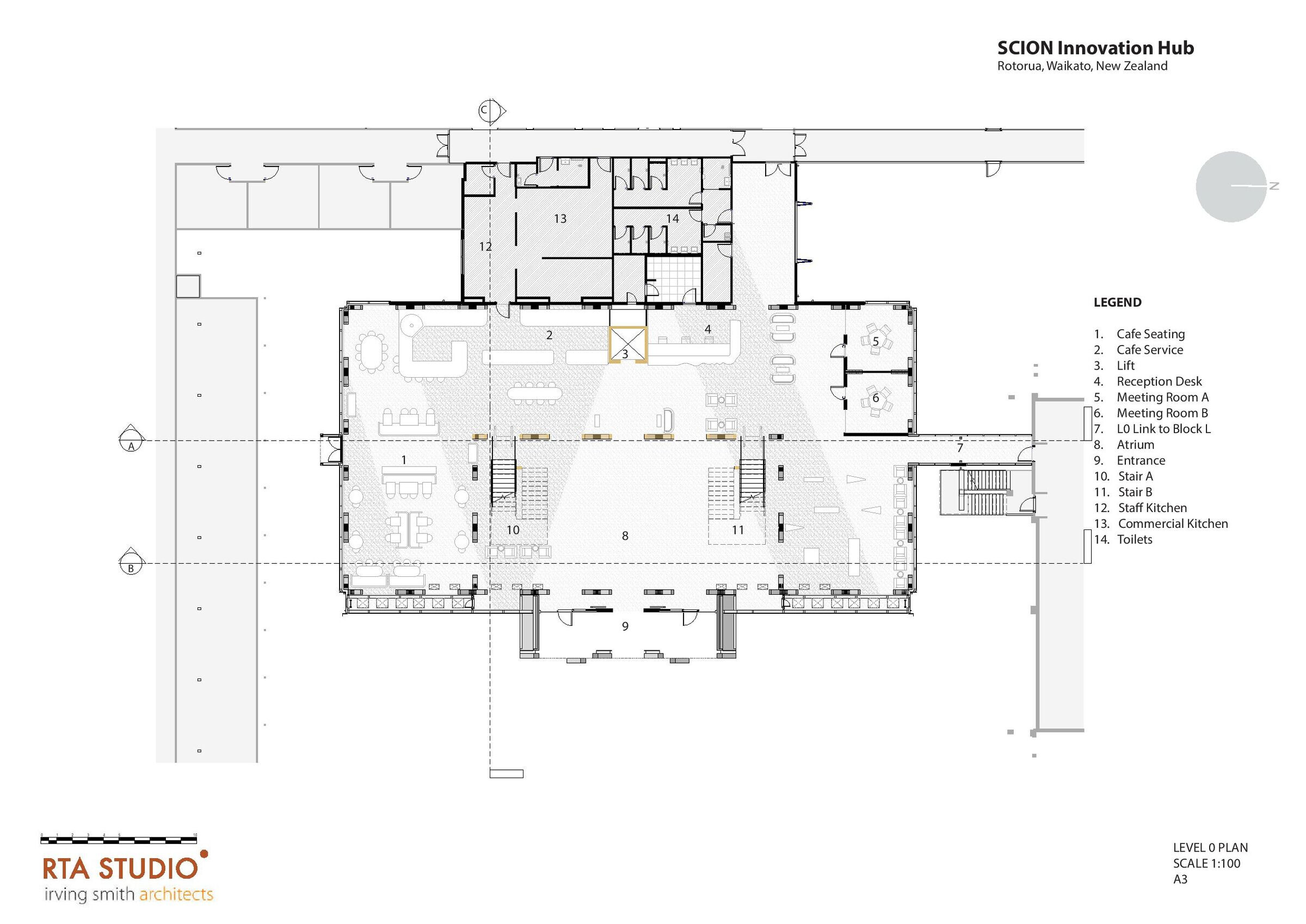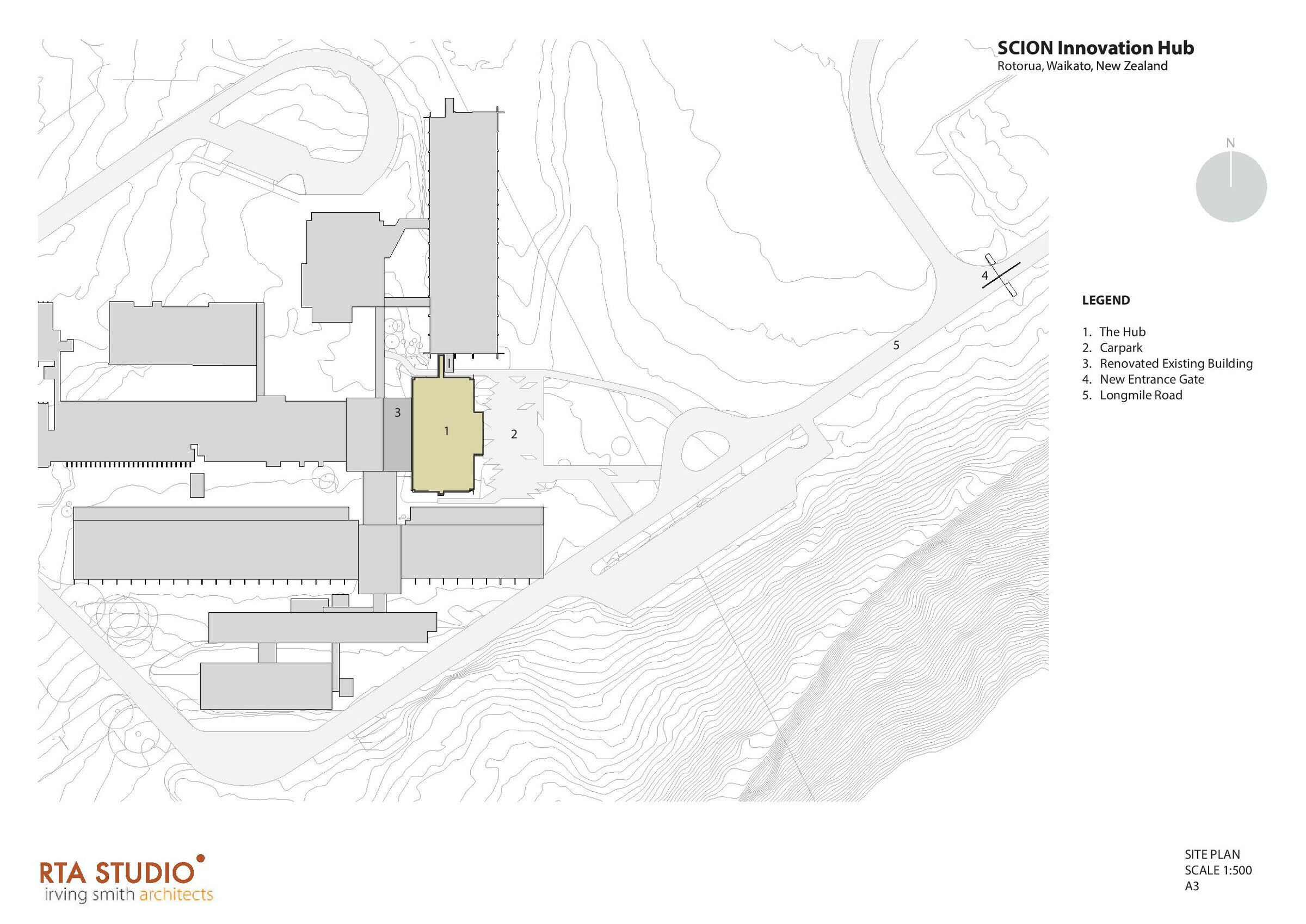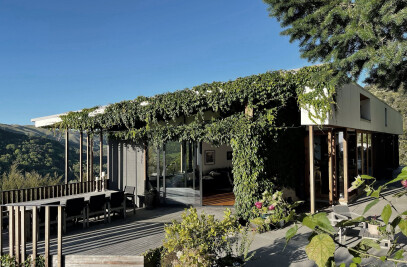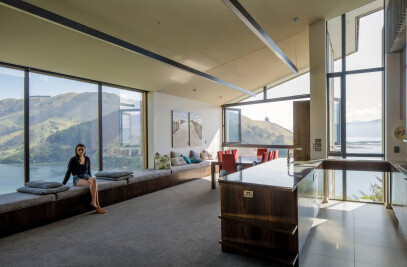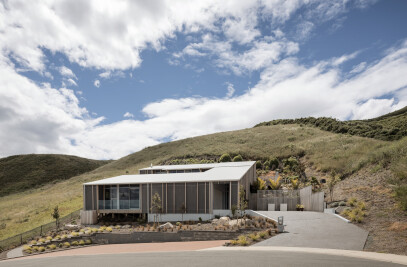RTA Studio and Irving Smith Architects was commissioned to reimagine the Rotorua headquarters of Scion, a Crown Research Institute that specialises in technology development for the forestry industry. Aptly located on the edge of the redwood forest in Whakarewarewa Forest Park, the project brings the workforce, previously siloed in smaller buildings dotted around the campus, into a central innovation hub while creating a new campus arrival point to strengthen the public interface for Scion.
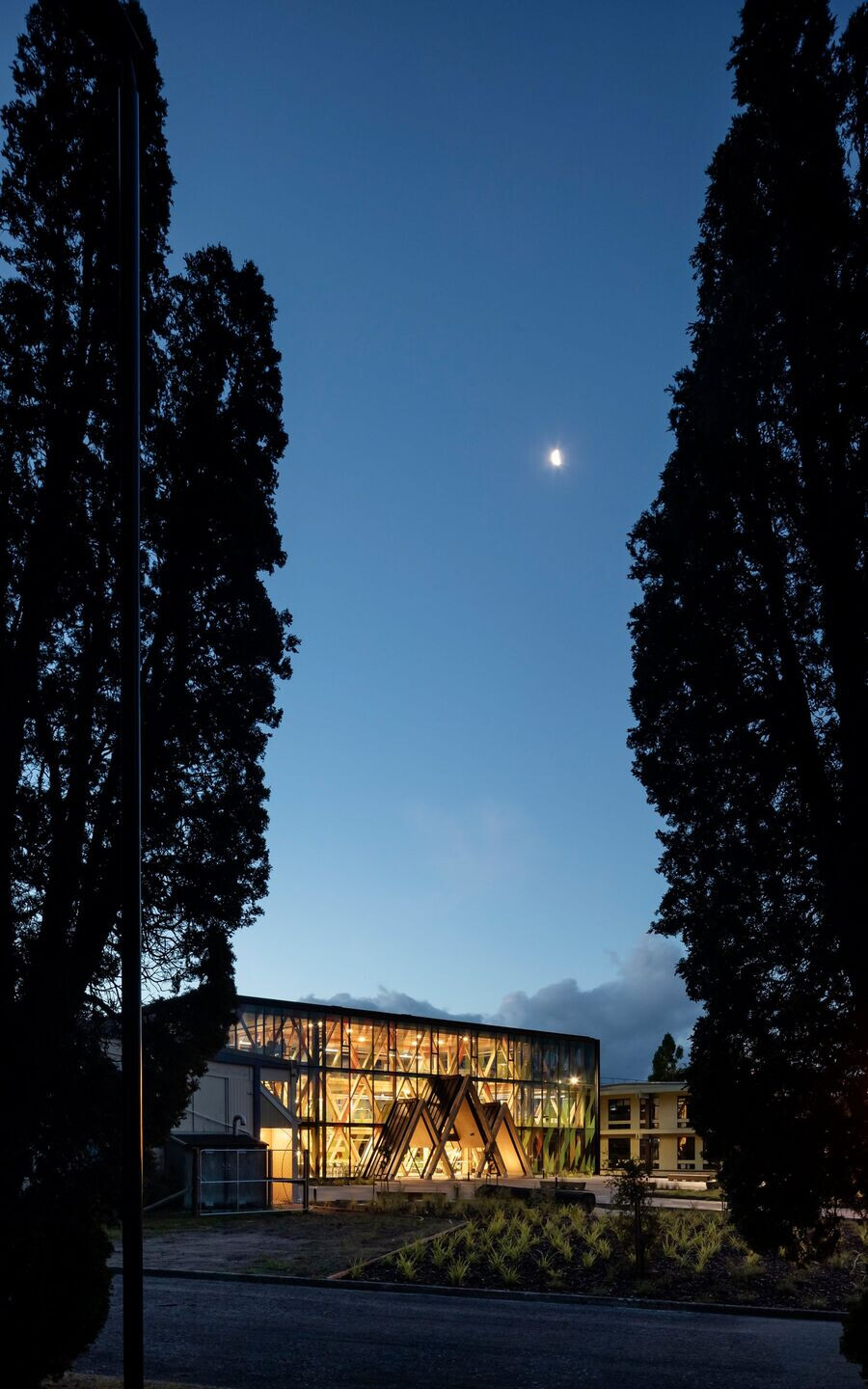
Named after Tuteata, an ancestor of the three local subtribes ‘Te Whare Nui o Tuteata’ is a cutting-edge showcase for engineered timber not only in terms of the aesthetic but what it contributes to a carbon-zero future. A trio of ‘peaks’ in gluelam timber, representative of the three hapu in the region, stand proud and tall at the entrance. Visitors pass beneath these portals to a triple-height atrium where a curated exhibition of wood-fibre technology and a café welcomes the public. Immediately present is the structural diagrid which rises three storeys to form the skeleton of the building. These structural elements are made of high-performing Laminated Veneer Lumber, and feature dovetail node joints which slot and glue together in an expression of craftsmanship. Looking upward from the atrium, the levels above provide the more private, acoustically considered open-plan office and collaboration spaces.
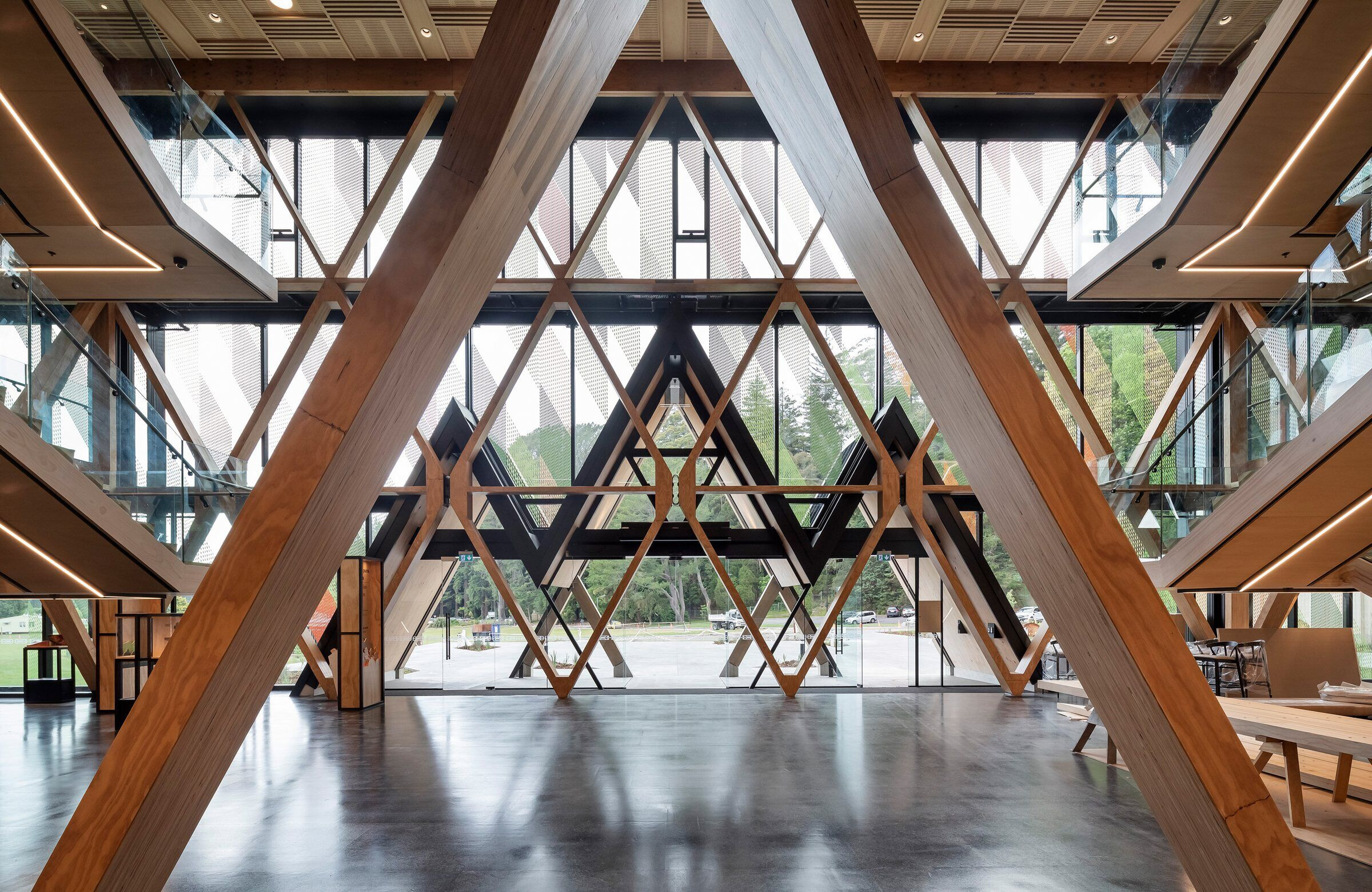
As assessed using the Etool system, the Scion Innovation Hub achieves embodied carbon zero at time of completion. Furthermore, to measure all of life and end of life carbon, the new building was assessed to achieve the 2030 target set by the RIBA (Royal Institute of British Architects) of 500kg of carbon/ msq. By using engineered products made from sustainably grown pine and putting more thought into the operational characteristics of a building, the building significantly contributes to New Zealand’s carbon-zero future to leave a much lighter footprint on the land.
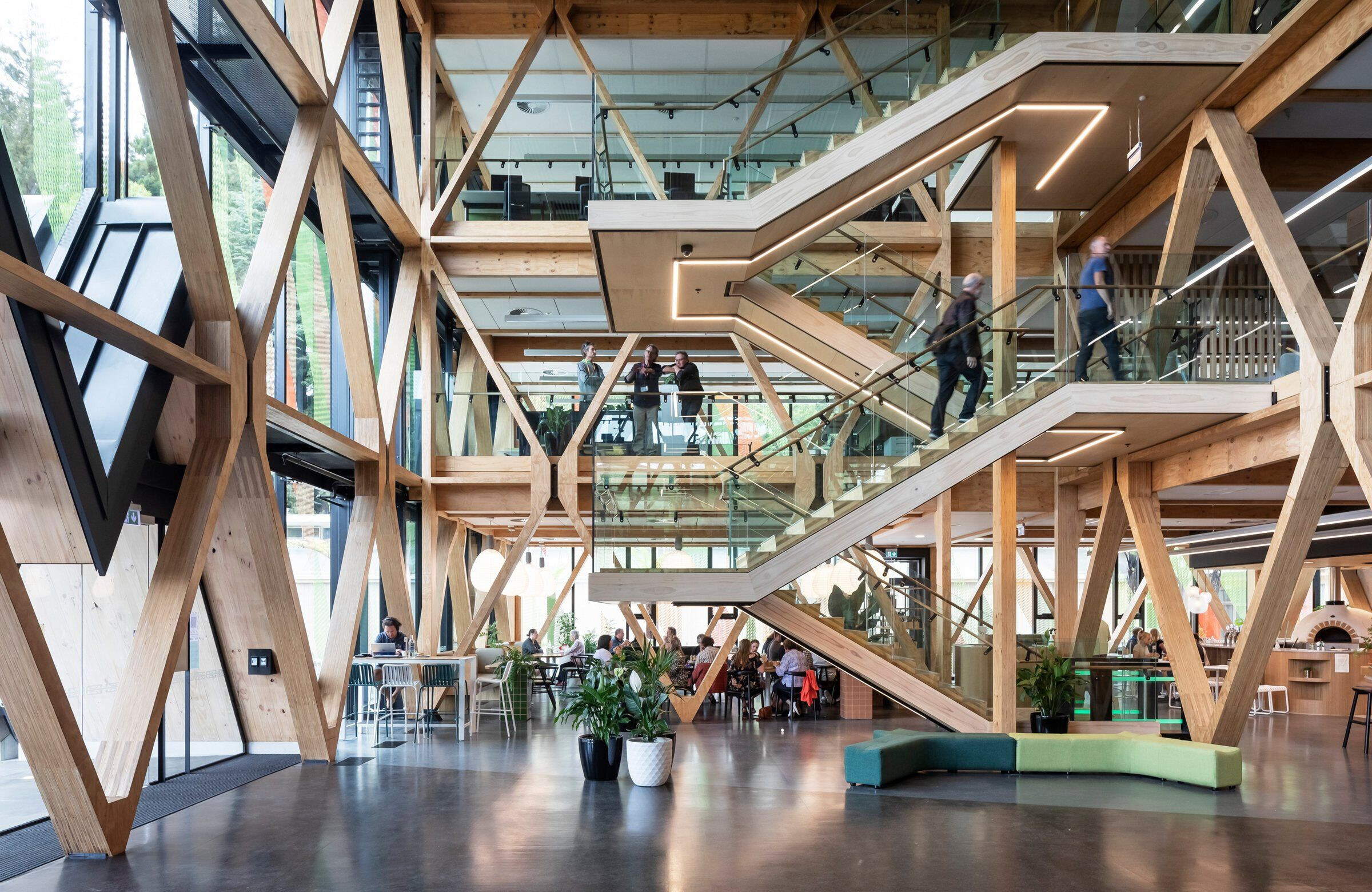
Client / Project brief
RTA Studio/Irving Smith Architects, were commissioned to reimagine the Rotorua headquarters of Scion. This Crown Research Institute specialises in technology development for the forestry industry and sits on the edge of a redwood forest. Key aspirational aspects of the brief achieved include:
- Creating a new front door and public face for Scion
- Showcase timber technology and exhibit Scion’s work
- Engage with the forest
- Acknowledge the cultural significance of the region
- Create a contemporary workplace environment
- Bring Scion together and better connect with public and commercial partners
- Creates a building and arrivals experience that will raise Scion’s profile.
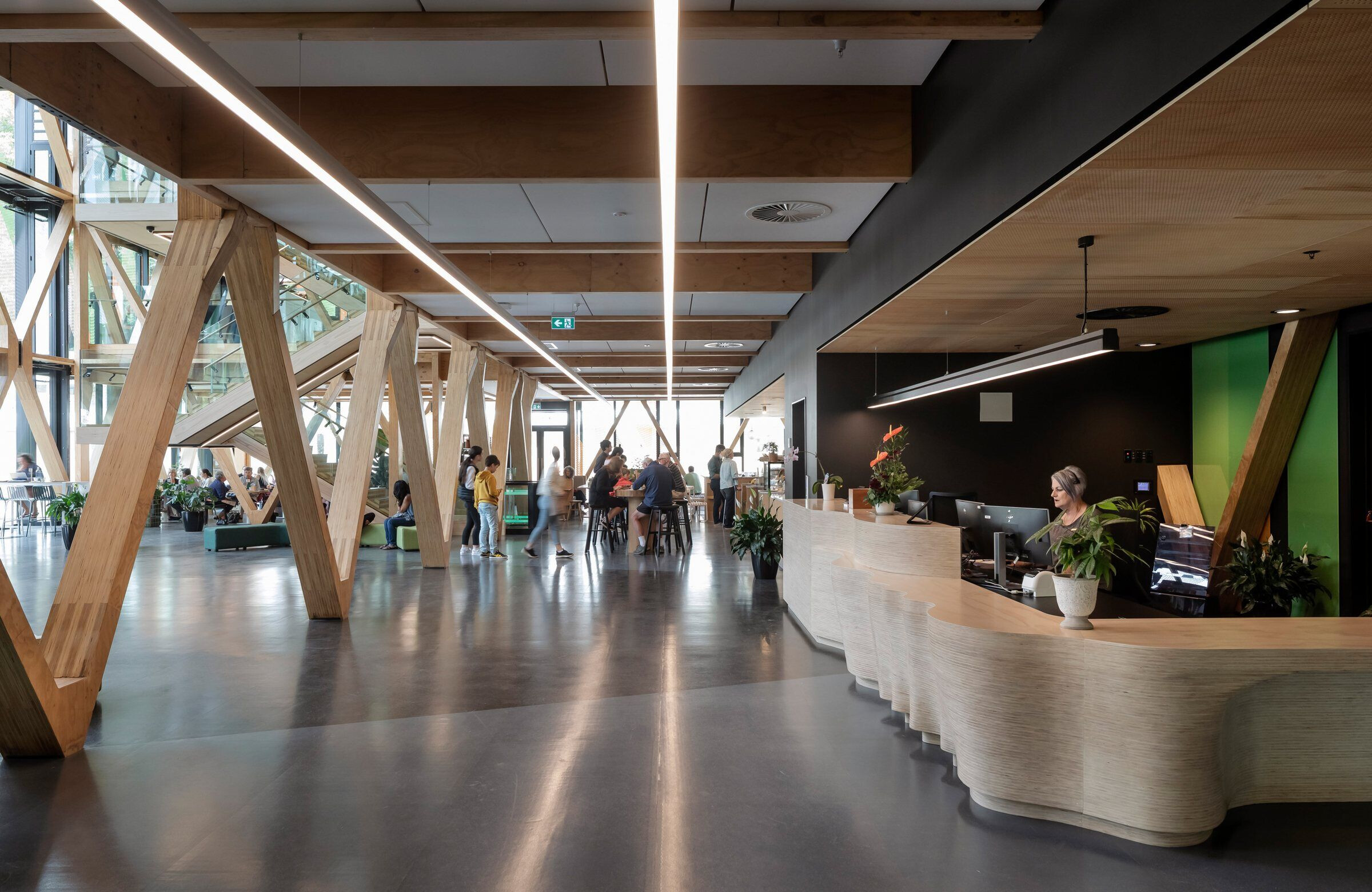
Response to brief
The key criteria of the brief were achieved through building orientation and positioning, careful material selection particularly timber and timber based products, collaboration with Iwi, and innovative thinking.
Aptly located adjacent the redwood forest on the northern edge of Whakarewarewa Forest Park in Rotorua, the project brings the Scion workforce, previously siloed in smaller buildings dotted around the existing campus, into a central innovation hub. Off the back of a detailed masterplanning process which sought to optimise site effectiveness, the new building is positioned centrally within existing key buildings comprising offices, science laboratories, workshops and nurseries. Significantly, the new building creates a prominent new campus arrival point at the end of Titokorangi Drive to improve the visitor arrival experience and strengthen the public interface for Scion.
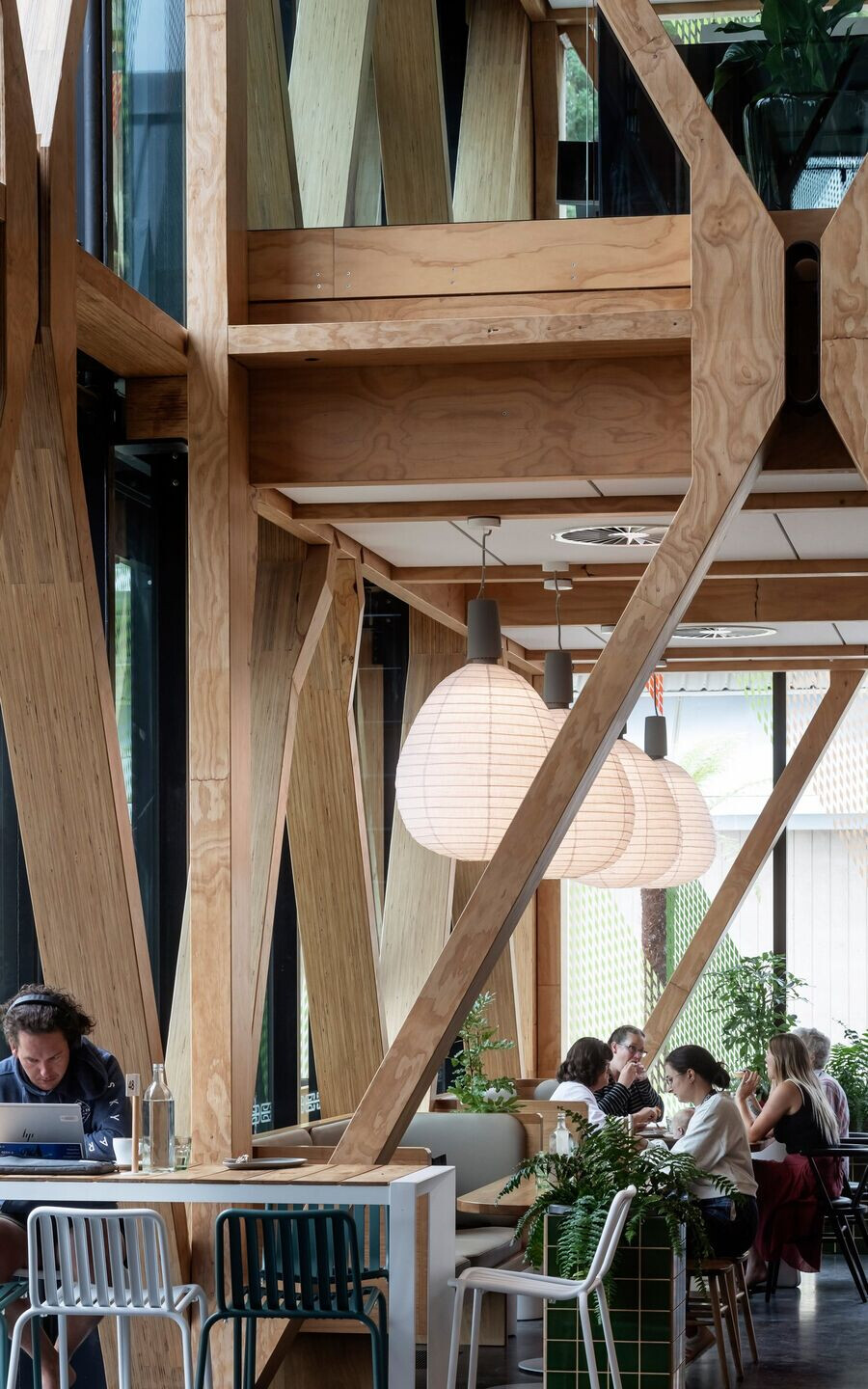
As a new insertion within an existing 50 year-old ageing campus, the building achieves a lot in improving the sprawling sites key adjacencies. Architecturally, the careful building placement consolidates and links the campus by relocating the existing Block G laboratories to enable the new building platform and boldly connects the new Hub to existing Blocks H (Orman Wing), Block E laboratories, triggering public H&S control points, and the recently refurbished Block L offices. This placement also capitalizes on the opportunity to shift the Scion entrance from the confused approach from Sala Street, to the more scenic approach through the towering redwoods along Titokorangi Drive. The Hub reveals itself to emerge in prime view as visitors pass through the entry gates.
Within the cultural context of Rotorua, the project benefitted from collaboration with NgāHapū e Toru who hold mana over the whenua.

Material and detailing intent
Key to the architecture is resolution and expression of the Timber Diagrid structure. The three level, Laminated Veneer Lumber structure, provides the gravity and lateral framework. The expression of the diagrid legibly demonstrates that timber structural buildings do not need to be designed like steel and concrete buildings.
The predominant use of timber illustrated primarily by the open mesh of the Diagrid is at the core of design with timber offering a negative carbon figure when evaluating the building’s carbon footprint.
Other key timber structural elements include:
- Lightweight Composite CLT and LVL floor system
- Timber Floor system at Ground Floor Level
- Exposed and cantilevered CLT stair elements within the three-level central atrium
- Overlay Acoustic floors to promote acoustics and building servicing
- A simple ‘Gang nail’ truss Roof Structure
- Double layer CLT acoustic partitioning
Exposing and expressing the timber structure is key to the architecture and interior, allowing the natural aspect of the material to provide and visually warm and inviting atmosphere. The raised acoustic floor system allows flexible running of services through the floor space allowing the CLT and LVL floor structure below to be exposed and showcased.
Prefabrication and careful co-ordination of timber components throughout has been key to the realisation of this project. LVL Diagrids are assembled from a limited number of repeating, multi storey components, to promote repetition, and to simplify both fabrication and site erection.
Structural Radiata Pine has been carefully paired with locally grown exotic hardwoods like Tasmanian Blackwood for handrails and leaners along with Victorian Ash for screening elements. The considered use of various woods offers an exceptionally tactile aspect to the interior with many visitors not being able to resist running their hand over the various timber elements seen through the buildings interior.
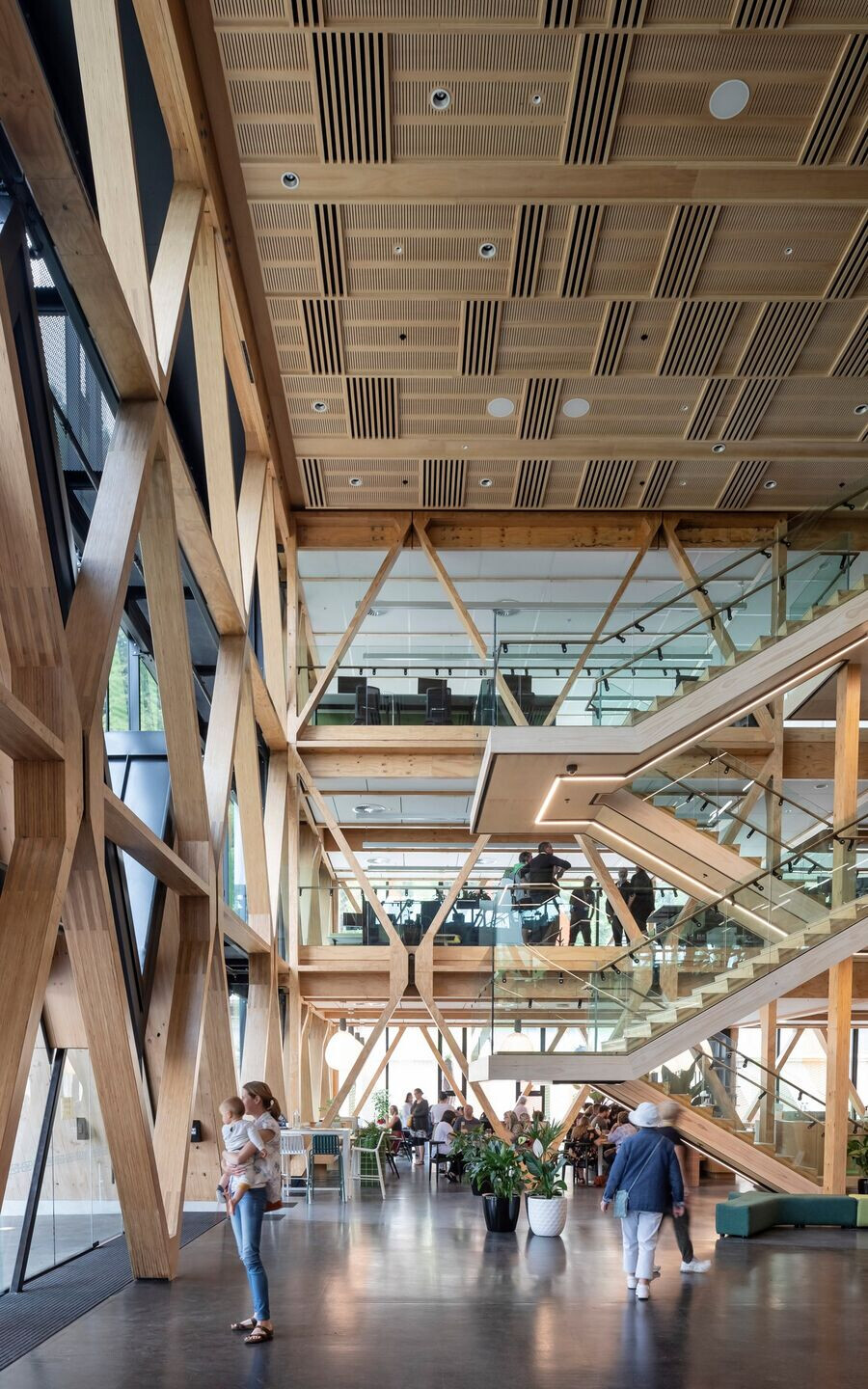
Innovation and creativity
Extensive prototyping and testing have allowed a laminated LVL structural nodes to be used at key junctions. The structural node transfers loads and holds a seismic fuse to yield and be replaced after an earthquake. With this simple shift in thinking the structural size of the timber diagrid members has reduced by around a quarter, creating a fine edge that gets thinner up through each building level as the loads decrease. Key also is designing the diagrid as a series of components; diamond and triangles, to simplify prefabrication and assembly.
The spatial form, structure and envelope are integral with the building’s innovative sustainability initiatives. Structural elements provide an organising element for services reticulation and the floor plate arrangement, together with the double skin east facing glazed façade, work intrinsically with the mixed mode ventilation strategy. Extensive glazing offers an abundance of natural light to limit active lighting with the design strategy for the fritted pattern to the facade evoking the soft diffuse light of a leafy forest, as well as being vital for the building’s thermal strategy. Used in conjunction with low-e performance glazing to regulate the internal temperature and loads,the pattern increases frit density to north and western facades and alters in gradient up the height of the building to help regulate internal temperatures.
The building operates with mixed mode ventilation based on a user-controlled traffic light systemwhich tells the user when to switch between active and passive modes within their respectivethermal zone. The double skin office wings are used for solar preheating and as a de-stratification path from the triple-height public atrium back to the air handling plant in the winter with the atrium allowing ductless supply of outdoor air.
Low energy lighting and low water usage sanitary fittings are utilized, which together with the mixed mode ventilation system means the building runs at a modelled energy usage of 80kwh/m2/year and water usage 12.6l/person/day which is a 34% reduction in operational impacts when compared to equivalent “baseline” reference building.
An innovative CLT acoustic partitioning system was developed for the meeting room spaces to further showcase the use of CLT as a flexible and versatile material. Put together as a double layer of solid timber with acoustic insulation between, the build-up achieves the required STC ratings. The meeting room doors themselves are also CLT cut from the outer 60mm CLT panel. The full outer face of door and wall panel has been routed with a simple pattern to reference the geometry of the diagrid structure.
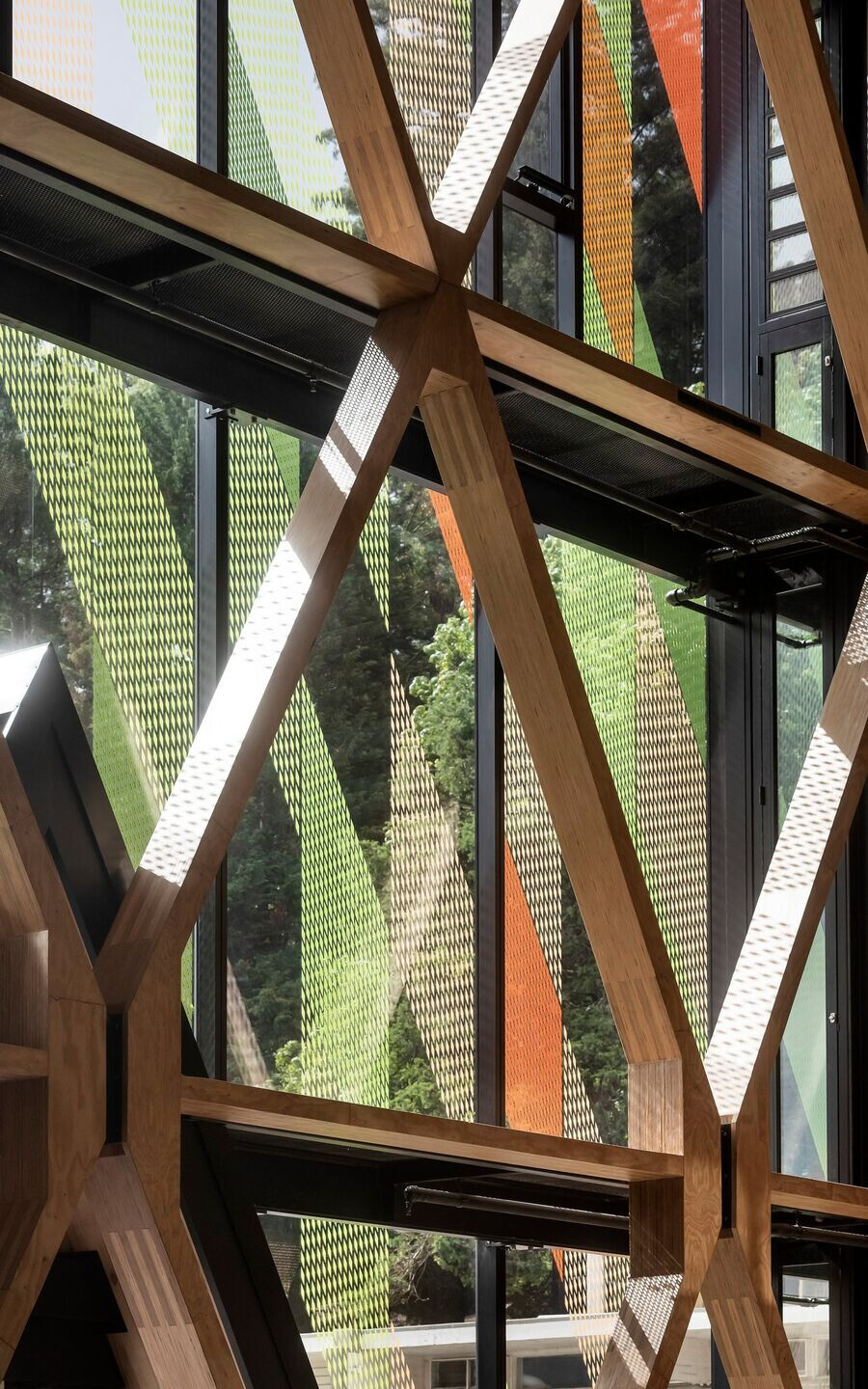
The reception counter utilizes locally grown, Radiata Pine plywood panels which have been CNC machined, layer by layer, to achieve an organically curving wood form, reminiscent of a fallen log in the forest.
Collaboration with Iwi was highly beneficial and culminated in the building being named “Te Whare Nui o Tuteata” as gifted by NgāHapū e Toru who hold mana over the whenua. The name Te Whare Nui o Tuteata acknowledges the mana of the tupuna Tuteata, from whom NgāHapū e Toru descend and the connection to the whenua, Titokorangi. Representative designer, Grant Marunui, contributed maoripatternwork for the arrival canopy and glass manifestations through-out the building.
The triple-height atrium leads up to a spectacular custom-designed wooden ceilinginspired by the structure of a radiata pine genome with lighting reflecting the Matariki night sky. Timber battens and plywood panels in subtle tones depict the barcoding effect from the plant DNA. The arrangement of atrium ceiling lights represents the Matariki star cluster, which is treasured in New Zealand and spoken of as mother Matariki and her six daughters. The reappearance of the Matariki stars signals the beginning of the Māori New Year.
